Intel NUC 13 Pro NUC13ANKi7 Internal Hardware Overview
Inside the system, we get a very familiar layout. The included Intel AX211NGW WiFi card is at the top. There is a PCIe Gen4 x4 M.2 slot for M.2 2280 (80mm) SSDs. Below that is a B-Key SATA M.2. Below that are the SODIMM slots.
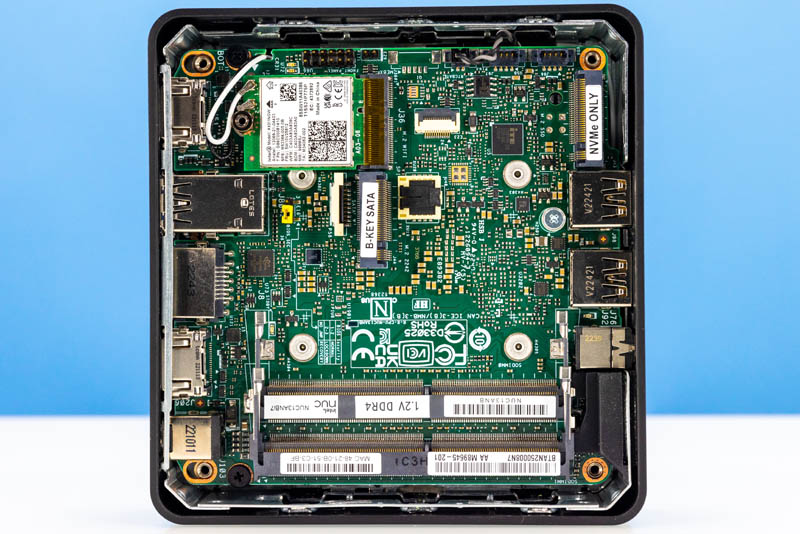
Our review unit came with a Kingston DDR4-3200 kit. We also tried our 64GB (2x32GB) DDR4-3200 G.Skill kit and that worked flawlessly in this system. The SSD was a 512GB Samsung PM9A1.
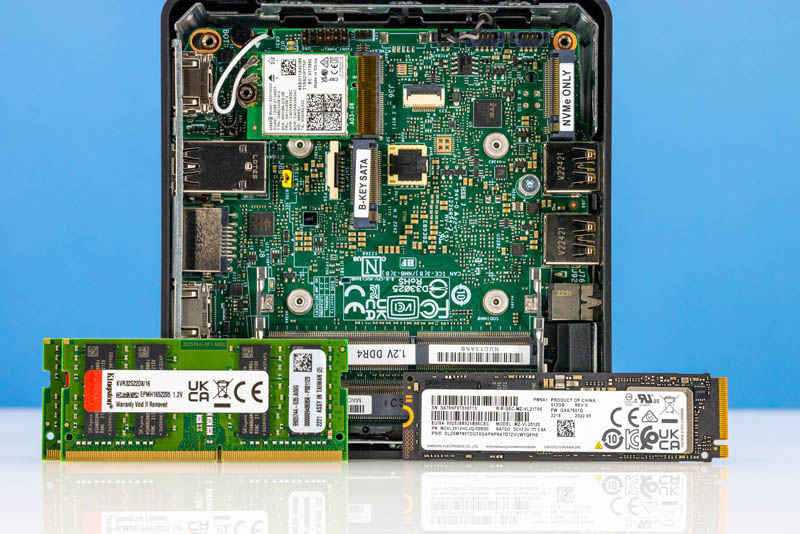
That Samsung PM9A1 brings us to a small but useful feature. The NUC 13 Pro, like the NUC 12 Pro, has a small cooling plate with pads for the SSDs. Even though there is not a lot of cooling for the bottom of the chassis, this helps when running PCIe Gen4 NVMe SSDs.
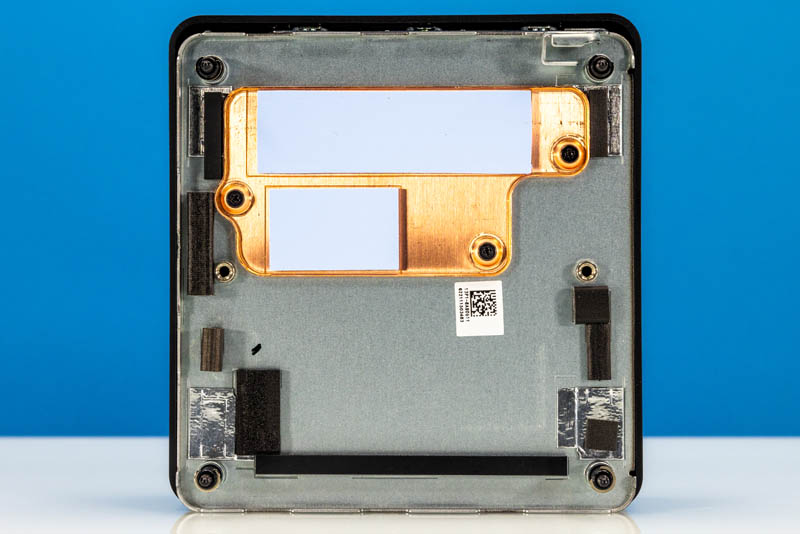
Here is a look at the system with everything installed.
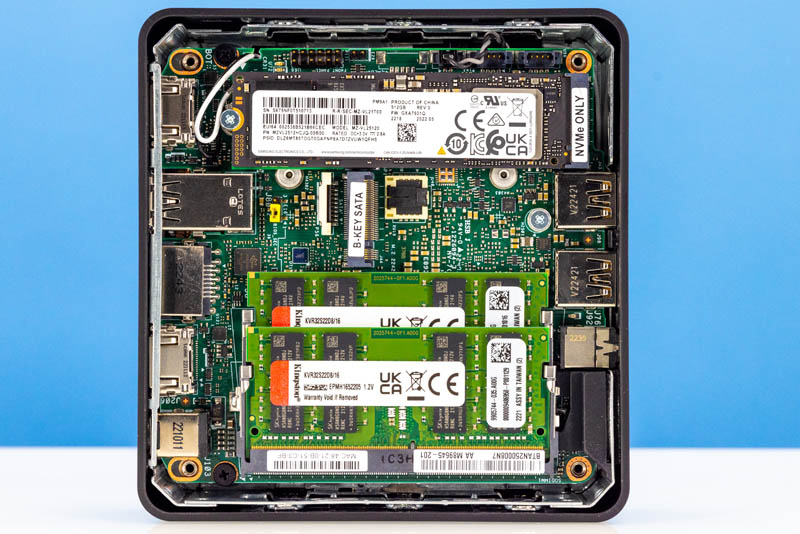
The Intel AX211 WiFi card sits below the M.2 NVMe SSD.
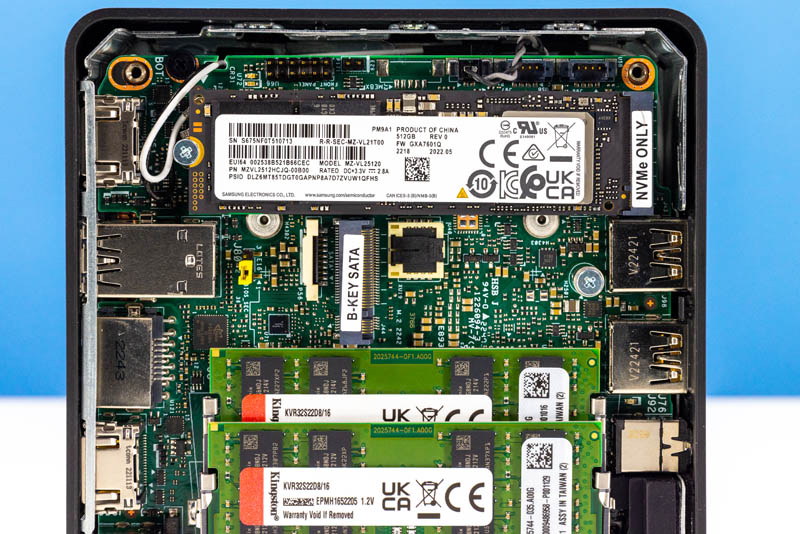
Here is a look at the motherboard with cooler from the rear port view.
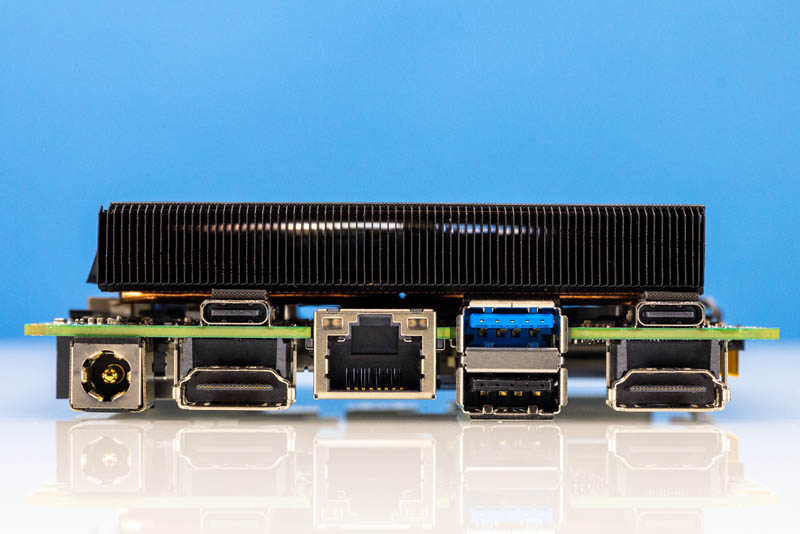
Here is a view from the front USB ports.
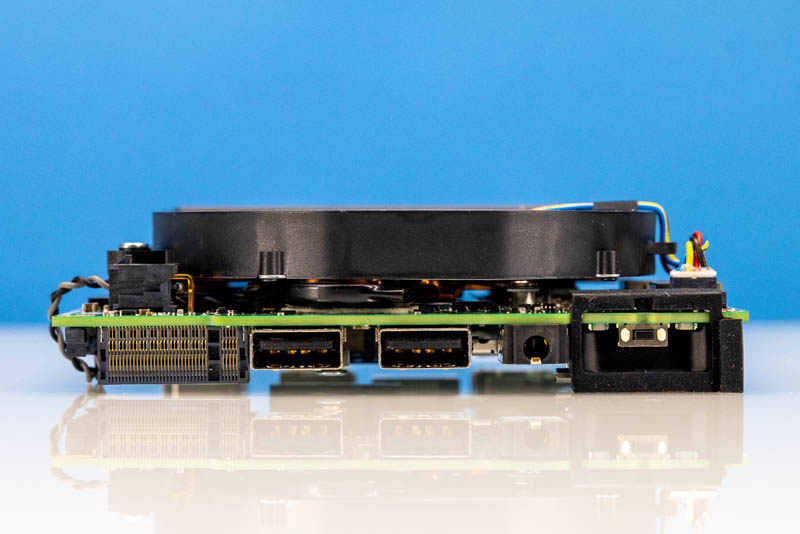
Here is a side view:
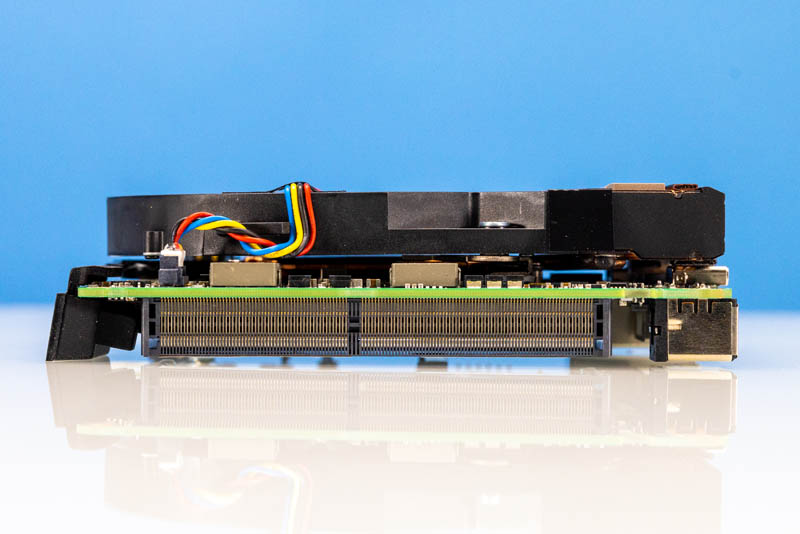
This is the copper cooler and fairly large fan that cools the Intel Core i7-1360P.
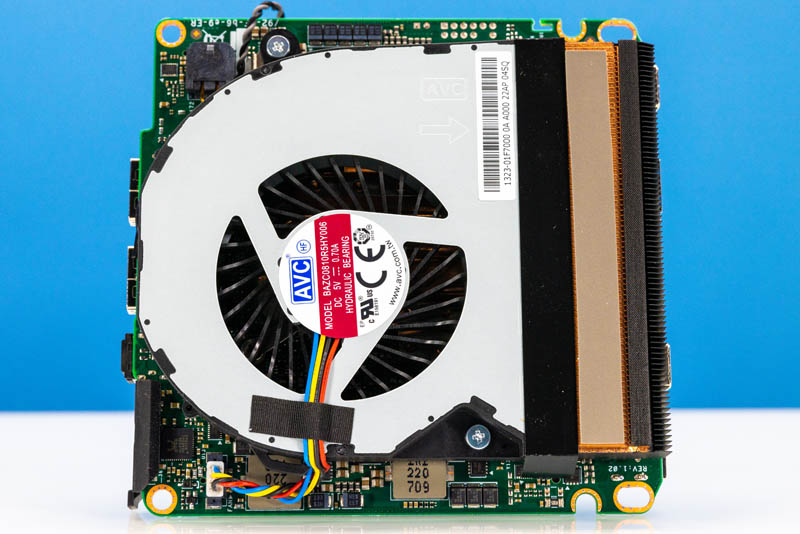
Next, let us get to the performance.
Intel NUC 13 Pro NUC13ANKi7 Performance
Instead of going through the entire Linux-Bench test suite, we are going to show a few performance and power numbers here to give a general sense of performance. This also gives us the opportunity to test with Linux/ Ubuntu instead of just Windows.
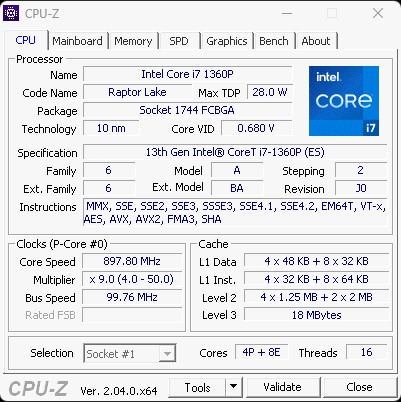
The CPU in this system is a 13th Gen Intel Core i7-1360P. This chip has four P cores and eight E cores. Something that is fun is that we saw the P core hit 5.0GHz which is crazy in a small PC like this.
Python Linux 4.4.2 Kernel Compile Benchmark
This is one of the most requested benchmarks for STH over the past few years. The task was simple, we have a standard configuration file, the Linux 4.4.2 kernel from kernel.org, and make the standard auto-generated configuration utilizing every thread in the system. We are expressing results in terms of compiles per hour to make the results easier to read:
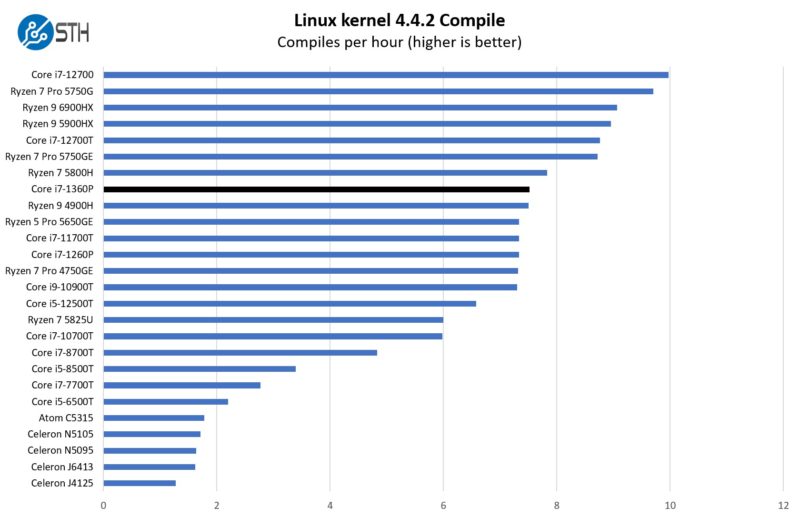
The theme that we are going to see here is that the Intel Core i7-1360P is faster than its predecessor, the Intel Core i7-1260P. Still, having the same core configuration means that we are going to get similar results.
7-zip Compression Performance
7-zip is a widely used compression/ decompression program that works cross-platform. We started using the program during our early days with Windows testing. It is now part of Linux-Bench.
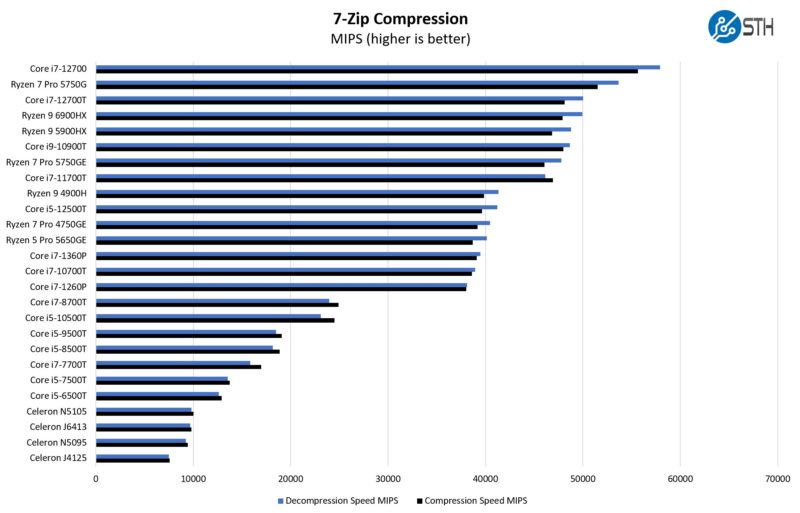
We see a similar pattern in the 7zip results.
OpenSSL Performance
OpenSSL is widely used to secure communications between servers. This is an important protocol in many server stacks. We first look at our sign tests:
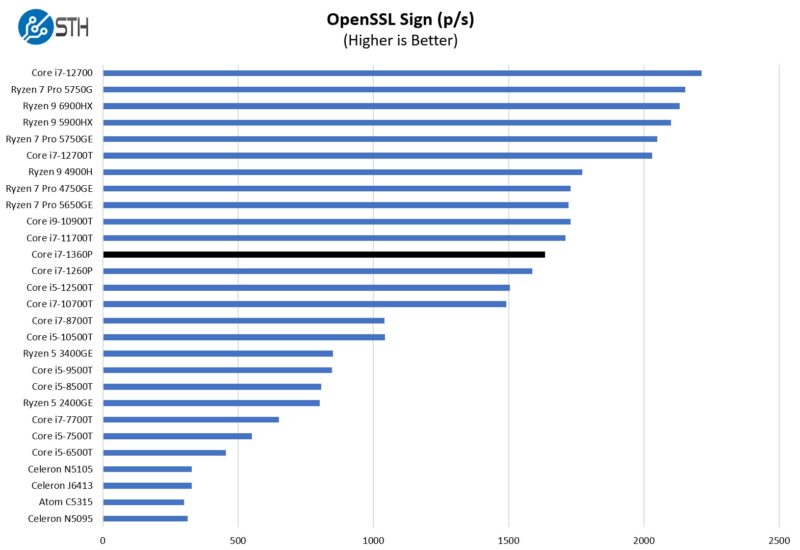
Here are the verify results:
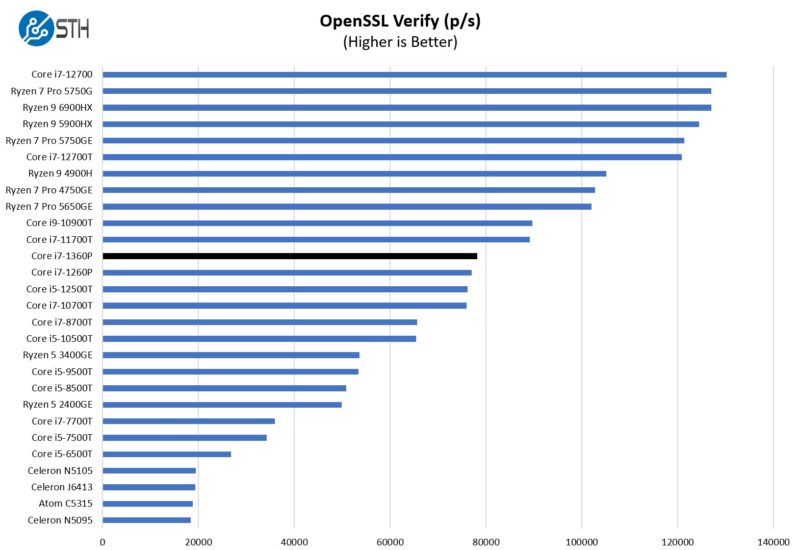
Again, we saw an improvement for the new generation, albeit not an enormous one.
Comparing Nearest Competitors
To make things a bit more interesting for the video since we saw the above, we purchased the ASRock Industrial NUCS BOX-1360P/D4 which is ASRock’s 4×4 NUC with the same Core i7-1360P processor. We used the Intel NUC 12 Pro with the Core i7-1260P as the 1.0 baseline just to show an interesting relative performance chart.
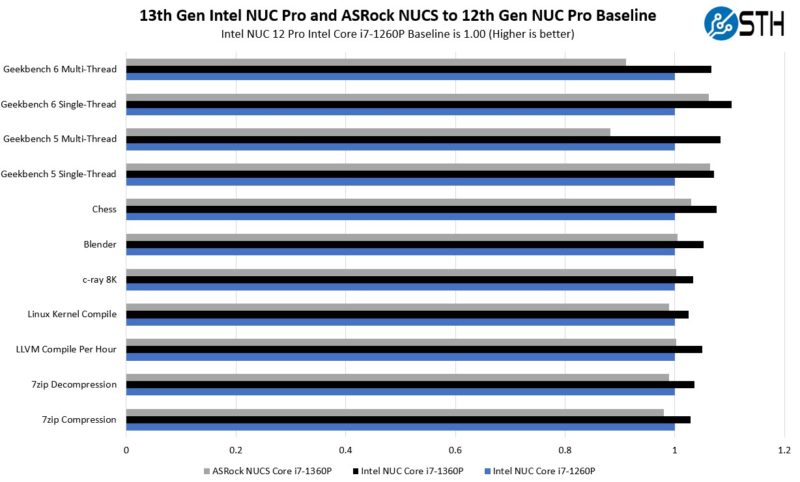
The Intel NUC 13 Pro was the fastest of the three small kits. The bigger finding was that it was significantly faster than our ASRock NUCS BOX with the same CPU.
We are going to discuss a bit why in our power consumption and noise section next.




How do you rate the fact that DDR4 is installed instead of DDR5? Especially since DDR5 is a huge step forward.
To Ignorant Consumer
DDR4 is more than adequate for the use cases this machine is built for. That being said – I also would have preferred DDR5 SODIMMs – With both the NUC12 and NUC13 coming out so close to each other I would have hoped the 13 would have had DDR5. Most of my deployed (100+) NUCs are all NUC11 Pro (1185G7/vPro) – and memory (same DDR4 3200) is not a bottleneck.
Thunderbolt on the PC is still trying to catch on. I use the Tiger Lake NUC11 Pro as desktop PCs – over 100 deployed – and use TB to connect a Sonnet TB3 to SFP+ – and is faster than both the Intel 10Gb/s and the Mellanox 10Gb/s NICs. The logs for the switch (SN4700) and the PC logs never once show a disconnection – which USB liked to do with NICs.
Where to buy? No info on STH YouTube video. There’s a mention but no linkage. Google search was not productive. Usually Its easy to find stuff. Not in this case. Sorry if I just missed something.
I would like to have an easy way to find out what NUC comes with vPro Advanced (iKVM), as it currently is very difficult.
@casper all of the “v” SKUs are vPro Enterprise eligible, which includes iKVM.
On page 1 you go over the ports on the back but don’t tell us what the USB-C port are. Can you add that?
“The rear of the unit has the most exciting set of ports. There is a DC power input. Then there are two HDMI 2.0b ports. In the middle, we get an Intel i226 LAN port.
USB is more exciting. We get two Type-A ports, one is USB 2.0 the other is USB 3.2 Gen2 (10Gbps.)”
Also, you never mention that the LAN port is 2.5Gb? I found that on another site’s review. There are a lot of omissions in this article.
On page 3 you discuss the NUC as if you’re comparing to another unit but you don’t give us the results for the other unit.
Look at how power consumption is discussed: “Beyond just the power consumption differences, there was a large gap in the fit and finish of the Intel NUC versus the ASRock alternative.”
But you don’t give us a link to the ASRock unit or tell us how the ASRock unit performed. Can you add that info to this article?
@Jeffrey W. Baker, thank you. Just what I needed.
Hi,does it fit Samsung 980 PRO 1 TB Heatsink?The built-in coolers NUC 13 Pro Arena Canyon of NVMe ,don’t they get in the way? Thanks!
@Georgi Nothing with a heatsink would fit in this case. You would either need to remove the cooler from the SSD or use the taller “H” version of this NUC where you can remove the internal heat bracket, leaving plenty of airspace. But I think the former is a better plan.
On page 1, where you describe the ports at the rear, you fail to mention the two TB4 ports.
Do the two TB4 ports share 40Gbps bandwidth, or do they each have 40Gbps bandwidth available individualy?
Can I add a second mini NVME SSD to the Intel NUC 13 Pro?